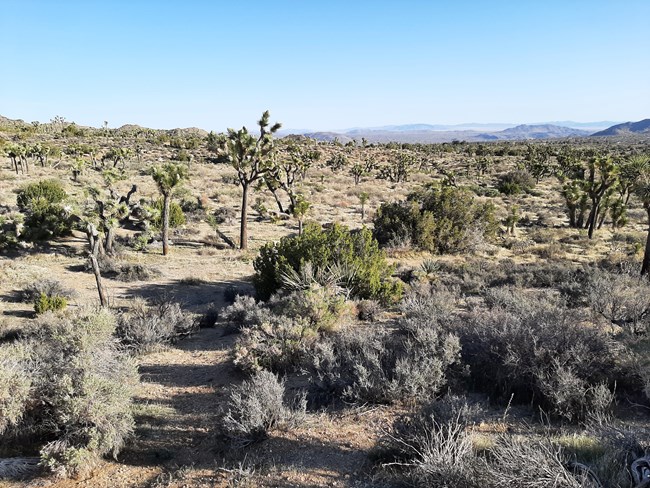Last updated: May 17, 2022
Article
Addressing Multiple Threats to an Iconic Species in Joshua Tree National Park

NPS Photo
Joshua Trees and Fire
The namesake species of Joshua Tree National Park is threatened on multiple fronts. With a warming climate, habitat suitable for Joshua trees (Yucca brevifoia var. brevifolia) within the park is predicted to shrink by 80-85% by the end of the century in a moderate warming scenario (Sweet et al., 2019). More so, if carbon dioxide emissions are not curtailed, habitat shrinkage within the park could exceed 99%. Joshua tree refugia habitat is limited to higher elevation, higher precipitation, and lower maximum temperature areas such as Covington Flats. Even if future warming is moderated and suitable habitat for Joshua trees continues to exist in the park, wildfire in these refugia habitats could extinguish remaining Joshua tree populations. As much as 15,000 acres of Joshua tree habitat within modeled refugia have already burned in earlier wildfires in 1995, 1998, 1999 and 2006.
Joshua trees are not fire adapted, as the species did not evolve under selective pressures that would favor adaptation to wildfire (Brooks and Matchett, 2006). The historic, pre-settlement interval between fires in Joshua tree woodlands is estimated to be about 250 years. However, the introduction of invasive alien annuals, such as red brome (Bromus rubens), cheatgrass (Bromus tectorum), and Mediterranean grass (Schismus spp.) created vast, connected fine fuels on a landscape scale. Consequently, more fuels and a warming climate cause more frequent and intense fires. The abundance and connectedness of these fine fuels is highly correlated with precipitation; the greater the precipitation, the more these grasses grow. Often, wildfires have devastating consequences on Joshua tree populations, as seen in 2020 at Cima Dome in Mojave National Preserve. Currently, wildfires in Joshua tree woodlands tend to be high intensity fires that burn most of the trees and replace them with new ones.
Addressing the Problem
Joshua Tree National Park is reducing their carbon footprint through ambitious energy goals and fire-suppression partnerships. Park management set a goal of converting 95% of the vehicle fleet from gas to electric by 2030. Additionally, management hopes to generate most power needs through cleaner and greener sources by doubling solar energy systems at all park facilities.
In addition to facility efforts, scientists are working together to address the problem hands-on. The park is a member of the California Desert Interagency Fire Program (CDIFP), a Bureau of Land Management (BLM) and NPS collaboration to proactively address wildfire risks. Using predictive modeling, NPS and BLM are collaborating to design and construct fuel breaks, which are changes in vegetation that create a buffer to fire spread. Fuel breaks will protect unburned Joshua tree refugia habitat from future fires.
James Gannon, CDIFP Fuels Specialist with decades of fire experience in the Mojave, assisted Neil Frakes, former Supervisory Biologist at the park, with the design and prescription of fuel breaks in the refugia. The plan required careful thought, as roadside fuel breaks also needed to retain a natural appearance to preserve the park visitor’s experience. Vegetation and fire specialists used chainsaws and string trimmers to construct the fuel breaks within 63 acres at Covington Flat and south of Black Rock campground. Constructing these fuel breaks required a vast investment of contracted and internship labor over two years. Maintenance of fuel breaks is essential to their continued functionality and is a difficult task, especially in high precipitation years when the invasive grasses increase production and, therefore, increase the associated fire risk.
In 2022, park staff began using herbicides to control invasive annual grasses and maintain fuel break effectiveness. Park Vegetation Branch staff and Lake Mead Invasive Plant Management Teams are treating the fuel breaks with Rejuvra (indaziflam), a pre-emergent herbicide labeled for use in natural areas, including parks, open space, wildlife management areas, recreational areas, fire rehabilitation areas, and fire breaks. Rejuvra binds to soil particles and inhibits the production of plant cell walls (cellulose biosynthesis) in a germinating seed. In 2019 and 2020, the Vegetation Branch made trial applications of Rejuvra to assess control of annual bromes and Mediterranean grasses. The herbicide generally does not affect established perennial vegetation, and control of annual grasses has been very effective for up to three years after application.
Park vegetation staff are also hoping to take advantage of 2022 being a mast seeding year – the first time in three years that most of the Joshua trees in a population are blooming. The mast event provides an opportunity to harvest Joshua tree seeds from populations across the park for storage locally at the park and nationally at the National Laboratory for Genetic Resource Preservation (formerly the National Seed Storage Laboratory) in Fort Collins, Colorado. Storing and preserving Joshua tree seeds retains genetic information for use in future opportunities to plant Joshua trees within burned areas, select genotypes best adapted to high temperature and moisture stress, and assist migration outside park boundaries in response to a warmer climate. Together, with fuel break management and seed collection, NPS staff hope to effectively protect the park’s iconic species.
References
Brooks, M. L., and J. R. Matchett. “Spatial and Temporal Patterns of Wildfires in the Mojave Desert, 1980–2004.” Journal of Arid Environments, vol. 67, Jan. 2006, pp. 148–64. DOI.org (Crossref), https://doi.org/10.1016/j.jaridenv.2006.09.027.
Sweet, Lynn C., et al. “Congruence between Future Distribution Models and Empirical Data for an Iconic Species at Joshua Tree National Park.” Ecosphere, vol. 10, no. 6, June 2019. DOI.org (Crossref), https://doi.org/10.1002/ecs2.2763.
